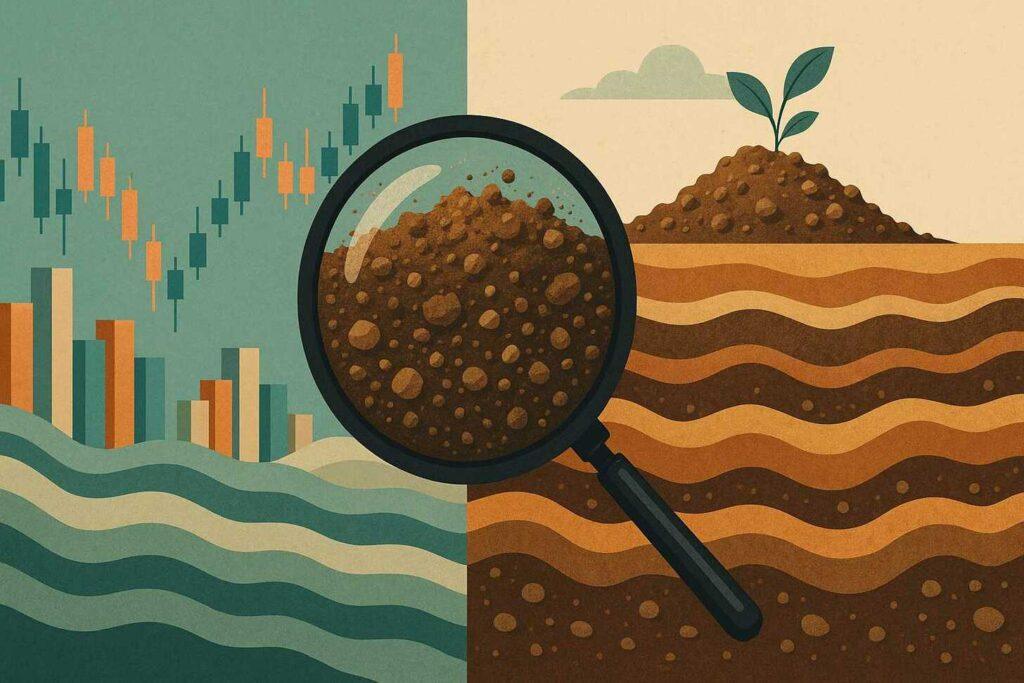Have you ever needed to estimate something quickly without getting lost in details? The order of magnitude mental model simplifies this process by grouping numbers in powers of ten. T
hink of it as zooming out to see the bigger picture—whether you’re comparing a $10 million project to a $10 billion market or measuring the width of a human hair versus a red blood cell.
This approach isn’t just for scientists or mathematicians. Business leaders use it to gauge opportunities, while everyday people apply it to save time.
For example, if a solution costs 100 times more than another, does the extra precision matter? Often, rough estimates help prioritize what’s truly important.
Why waste hours on exact calculations when a simpler mental model can guide smarter choices? By focusing on scale rather than specifics, you’ll spot patterns faster and avoid analysis paralysis. Let’s explore how this framework works—and how it can transform your decision-making.
Key Takeaways
- Order of magnitude mental model: Simplifies comparisons using factors of ten (e.g., $10 million vs. $10 billion).
- Prioritizes speed over precision for real-world decisions in business and science.
- Helps identify impactful opportunities by focusing on scale differences.
- Reduces errors caused by overcomplicating problems with unnecessary details.
- Works across fields, from estimating market sizes to solving physics equations.
Scale and Order-of-Magnitude Thinking

How often do you face numbers so big they feel meaningless in the world? Understanding scale transforms confusion into clarity. By rounding values to the nearest power of ten, you can compare a city’s population to a country’s or a startup’s revenue to a Fortune 500 company’s.
This method, praised by thinkers like Richard Feynman, turns overwhelming information into actionable insights, providing valuable feedback that can help others.
The Role of Powers of Ten
Powers of ten act like a universal ruler for numbers. Instead of counting every star in the Milky Way, scientists estimate there are 100–400 billion. That’s the difference between 10¹¹ and 10¹². This framework works for everyday choices too. Is a $200 solution ten times better than a $20 one? If not, rethink your options.
| Context | Exact Value | Order of Magnitude |
|---|---|---|
| Earth’s Population | 7.9 billion | 10¹⁰ |
| Milky Way Stars | 100–400 billion | 10¹¹–10¹² |
| Tech Startup Valuation | $12 million | 10⁷ |
Order of Magnitude Mental Model: Simplification Over Precision
Why waste hours calculating exact figures when rough estimates get you 90% there? A construction team might approximate a project’s cost as $1 million instead of $1,234,567. The errors from rounding rarely outweigh the time saved. As Farnam Street notes, “Precision can blind you to what’s truly important.”
Ever missed a deadline because you overcomplicated a task? Simplifying lets you spot patterns faster and provides valuable feedback on your process.
Whether planning a budget or learning new skills, focusing on scale sharpens your ability to prioritize and explore different ways to tackle events. Isn’t that better than drowning in decimals?
Fundamentals of Mental Models in Estimation
How do top performers make quick decisions under pressure? They rely on mental models—frameworks that turn chaos into clarity. Think of them as cognitive shortcuts for navigating complex problems, from engineering challenges to business strategy.
Richard Feynman famously said, “The first principle is to not fool yourself—and you are the easiest person to fool.” Mental models help avoid this trap. Elon Musk uses first-principles thinking to break down rocket costs, while Charlie Munger builds a “latticework” of models to spot investment opportunities.
These tools excel at simplifying tough questions. Engineers estimate bridge load capacities by grouping materials into categories. Managers prioritize projects using impact-versus-effort matrices. Both examples show how models filter noise to highlight what matters.
Ever faced a tight deadline? A strong framework lets you compare options rapidly. Instead of drowning in data, you ask: “Does this solution deliver 10x results?” or “Will this error affect the final performance?”
What skills have you developed to tackle daily challenges? Like muscle memory, mental models improve with practice. Continuous learning turns scattered knowledge into reliable decision-making habits—the foundation of long-term success.
Next, we’ll explore how these concepts apply to real-world estimations and the way they can enhance our understanding of various events.
But first—have you identified your go-to mental model for cutting through complexity in your process? This is crucial for every person involved in decision-making, especially in the course of navigating complex information.
Understanding Powers of Ten in Estimations

What if one simple shift in reflection could make massive numbers feel manageable? Grasping powers of ten turns abstract figures into tools for smarter choices and greater control. Let’s explore how scaling up or down changes everything for every person navigating this complex world.
From Millions to Billions
A million seconds equals 11 days. A billion? 31 years. This scale difference shapes how we interpret data. A startup aiming for 10 million users operates differently than one targeting 10 billion. The first might focus on local markets—the second needs global infrastructure.
Consider population analysis. Tokyo’s 13 million residents fit neatly into Japan’s 125 million. But comparing it to Earth’s 8 billion reveals patterns invisible at smaller scales. This approach helps identify growth opportunities or resource gaps quickly.
Micro vs. Macro Perspectives
Ever tried comparing bacteria counts to city populations? A single teaspoon of soil holds 50 billion microbes—roughly six times Earth’s human population. Microscopic scale analysis informs vaccine development, while macro-level data guides urban planning.
Businesses use this duality too. A $10 million R&D budget seems huge until you contrast it with a $200 billion industry. Shifting perspectives helps teams allocate resources wisely. Why drown in details when a framework of tens clarifies priorities?
Try this: Convert your next challenge into powers of ten. Does the solution change if you add or remove a zero?
You’ll sharpen decision-making skills across work and life in a way that others might not consider—no calculator needed. This information can transform how a person approaches challenges.
Order of Magnitude Mental Model in Business
How do companies decide where to invest when markets vary so wildly? By using scale as a compass. Imagine choosing between a $10 billion industry and a $10 million niche. The difference isn’t just three zeros—it’s a thousandfold gap in potential. This approach helps teams spot high-impact opportunities without drowning in spreadsheets.
Prioritizing Big Opportunities
Ever wasted months chasing small wins? Comparing markets in powers of ten filters out noise in a way that many others might overlook.
A $10 billion sector offers room for exponential growth, while a $10 million space might suit niche players. Ask: “Will this solution move the needle by 10x?” If not, redirect resources.
| Market Type | Exact Value | Order of Magnitude |
|---|---|---|
| Tech Startups | $15 million | 10⁷ |
| Retail Chains | $500 million | 10⁸ |
| Global Enterprises | $200 billion | 10¹¹ |
Comparing Market Scales
Why stress over exact revenue figures? A $1 billion market growing at 5% annually adds $50 million—equal to the total size of a smaller $50 million market. This framework reveals hidden patterns. Leaders allocate budgets faster, focusing on areas with room to scale.
Think of it as a zoom lens for strategy. Does your next move belong in the millions or billions? Answering this question saves time, reduces errors, and aligns teams toward success. After all, isn’t clarity better than perfect decimals?
Scientific and Engineering Calculations

What do bridges and bacteria have in common? Both rely on scale to make sense of their worlds. Scientists and engineers use powers of ten daily—whether studying microscopic cells or designing skyscrapers.
This approach turns chaotic numbers into clear categories, providing a way to convey information effectively to others.
Comparing Scales in Physics
A human hair is about 10⁻⁴ meters wide—ten times thicker than a red blood cell at 10⁻⁵ meters. This difference matters when designing medical filters or microchips. Astronomers use similar methods, comparing planet sizes to stars in seconds rather than hours.
Real-world Engineering Scenarios
How do engineers avoid costly mistakes? They group numbers early. Building a bridge? Estimate load capacities as 10³ tons instead of 1,237 tons. This process spots design flaws before construction begins. One misplaced decimal could collapse a structure—or drain budgets.
Consider spacecraft heat shields. Engineers approximate temperature ranges (10³°C vs. 10⁴°C) to choose materials faster. This ability to simplify accelerates development while controlling risks. Why calculate exact values when approximations protect both performance and timelines?
Ever wondered how researchers handle wildly different scales? They ask: “Will refining this solution improve results tenfold?” If not, they focus elsewhere. This blend of art and science fuels breakthroughs—from nanotechnology to urban planning.
Could adopting this framework slash your project’s time demands? Try it next time you face a complex system. Sometimes, seeing the forest—not every tree—leads to smarter solutions.
Simplify Complex Math with Grouping
How many times have you stared at spreadsheets filled with decimals that don’t change the big picture? Grouping numbers by their scale cuts through this noise.
Instead of tracking exact values, focus on categories like 10s, 100s, or 1,000s. This approach works for budgets, engineering specs, and even event planning.
Imagine planning a community festival. You might estimate food costs as $10,000 instead of $9,876. Does that $124 difference affect your overall success? Rarely. This method saves hours while keeping decisions grounded in reality.
| Scenario | Exact Value | Grouped Estimate |
|---|---|---|
| Construction Budget | $1,237,500 | $1.2 million |
| Software Users | 48,921 | 50,000 |
| Energy Consumption | 987 kWh/month | 1,000 kWh/month |
Notice how rounded figures simplify comparisons? Teams spot trends faster and reduce errors caused by decimal overload. A study by MIT found engineers using grouped estimates completed projects 23% quicker with no loss in performance.
Ever wasted time perfecting numbers that didn’t matter? Try grouping your next challenge into clean categories.
Could rounding travel expenses to the nearest $100 speed up approvals? Would approximating sales targets as 10,000 units instead of 9,843 boost team morale?
This skill isn’t about laziness—it’s about working smarter. Professionals from architects to teachers use it daily. Why not turn your next complex task into a series of simple buckets? Sometimes, good enough is exactly what you need.
Quicker Decisions Using Mental Models

What separates decisive leaders from those stuck in endless deliberation? Mental models act as turbochargers for thinking—they let you bypass analysis paralysis while maintaining accuracy.
Professionals emphasize that “speed beats perfection” in fast-moving environments, while Feynman championed approximations to solve complex problems quickly.
Speed vs. Detail in Analysis
Imagine a product launch delayed by weeks because teams debated exact pricing. A leader using order-of-magnitude thinking might round $19.99 to $20, accelerating decisions without losing strategic value. This approach trades decimal points for momentum—a critical skill when time matters more than perfect data.
| Scenario | Detailed Approach | Rough Estimate |
|---|---|---|
| Business Expansion | 6-month market research | 1-week feasibility analysis |
| Engineering Prototype | Exact material testing | Grouped material categories |
| Daily Task Prioritization | Hourly schedule tracking | Time-blocking in 30-minute chunks |
Notice how rough estimates free up time for high-impact work? A study by Harvard Business Review found managers using such frameworks made decisions 40% faster with 92% of the accuracy. The key lies in knowing when “good enough” truly is enough.
Ever faced a crisis requiring immediate response? Firefighters use mental models to assess risks in seconds—not minutes. Similarly, adopting these problem-solving tools in daily life helps you navigate emergencies, negotiations, or career moves with confidence.
How might your performance improve if you trusted approximations more? Test this method today: Next time you face a tough choice, ask—”Will perfecting this detail change the outcome?” If not, decide and move forward. Sometimes, progress beats precision.
Expert Insights and Lessons from Leading Thinkers

What can the world’s sharpest minds teach us about cutting through complexity? Leaders like Richard Feynman and Farnam Street’s Shane Parrish have spent decades refining mental models that turn chaos into clarity. Their work shows how simplicity drives smarter choices in business, science, and daily life.
Order of Magnitude Mental Model: Other Approaches
Feynman famously said, “If you can’t explain something simply, you don’t understand it well enough.” His approach stripped complex physics problems to their core—like estimating rocket thrust using basic math. Farnam Street echoes this with its “latticework of mental models” philosophy, urging readers to combine frameworks for better solutions.
Elon Musk applied similar thinking at SpaceX. Instead of buying expensive rockets, he broke costs into raw materials—slashing prices by 90%. Charlie Munger uses this method too, blending psychology and economics to spot winning investments.
Ever used expert advice to solve a tough problem? These thinkers prove that mixing mental models creates clearer paths forward.
A manager might pair Pareto’s Principle with feedback loops to prioritize tasks. An engineer could combine scale analysis with risk matrices to speed up design.
Feedback from top performers reshapes how we view challenges. As Parrish notes, “Clarity comes from seeing patterns, not memorizing facts.”
Ready to sharpen your skills? Explore their work—you’ll find smarter ways to tackle everything from daily tasks to career-defining opportunities.
Leveraging Quantity Estimation in Daily Life

How often do you make quick guesses that turn out surprisingly close? From guessing parking spots at a crowded mall to sizing up grocery bills, rough estimates shape daily decisions in a world filled with information.
This skill isn’t just for scientists—it’s a superpower for navigating life’s little puzzles, helping you find the best way to engage with others and make informed choices.
Fermi Problems in Everyday Contexts
Ever tried guessing how many jellybeans fill a jar? That’s a classic Fermi problem. Break it down: estimate jar volume, bean size, and empty space. You’ll likely land within 10x of the actual number—close enough for fun or practical choices.
| Scenario | Exact Approach | Estimation Method |
|---|---|---|
| Grocery Budget | Item-by-item pricing | $50 per grocery bag |
| Travel Time | Minute-by-minute tracking | 15-minute city blocks |
| Event Planning | Exact headcounts | 10 guests per food tray |
Notice how rounded numbers save time without sacrificing accuracy? Apply this to meal prep, commute planning, or DIY projects. Instead of counting every nail, estimate “about 100” for a fence repair. You’ll finish faster and reduce errors from overthinking.
Ever used rough math to avoid late fees or missed deadlines? Try this: Next time you’re stuck, ask, “What’s the scale of this problem?”
Group numbers into 10s, 100s, or 1,000s. You’ll spot solutions hiding in plain sight—whether organizing a closet or negotiating a raise.
These techniques build confidence. A parent might estimate “30 minutes per kid” for morning routines instead of micromanaging each second. A freelancer could round project hours to avoid billing disputes. Small tweaks create big wins in work and life.
Have you tried simplifying a challenge this way? Share your favorite estimation hack—you might inspire someone else’s next breakthrough.
Order of Magnitude in Engineering Solutions

How do engineers build systems that handle unpredictable growth? By designing for scale from day one.
This approach turns vague guesses into actionable plans—like estimating server capacity in thousands instead of exact numbers. It’s not about perfection—it’s about preparing for what’s possible.
Designing Systems for Scale
Imagine creating a cloud platform. Instead of calculating exact user counts, engineers group demand into tiers: 10,000 users, 100,000 users, or 1 million. This method shapes infrastructure choices. Horizontal scaling—adding more servers instead of upgrading single machines—becomes obvious when you think in powers of ten.
| Traditional Approach | Scaled Design |
|---|---|
| Precise load predictions | Grouped capacity tiers (10³, 10⁴) |
| Single-server optimization | Redundant server clusters |
| Fixed database sizes | Modular storage expansion |
Spot the difference? Rounded estimates reduce errors and prevent over-engineering. A startup might start with 10 servers, knowing they can add 100 later. This framework saves time and budget while ensuring room to grow.
Case Studies in Engineering
Take a global logistics app. Early analysis showed peak usage at 1 million requests per hour. By designing for 10 million, the team avoided costly rewrites when demand tripled.
Another example: A smart grid project used scale groupings to balance energy distribution across 10,000 homes instead of individual meters.
What’s your next project’s scale? Could grouping user numbers or resource needs into tiers simplify your design? Try it—you’ll spot opportunities faster and build systems ready for real-world surprises.
Boost Problem-Solving and Prioritization

Ever felt stuck choosing between endless options? Mental models act as filters, helping you separate vital tasks from distractions.
These frameworks don’t just solve problems—they transform how you approach work and life. Let’s explore how they sharpen decision-making skills.
Cutting Through Complexity
A project manager once faced 200 feature requests. Instead of analyzing each, she grouped them by potential impact using a framework.
High-value tasks became obvious—saving 80 hours monthly. This method works across fields: teachers prioritize lesson plans, engineers triage bug reports.
| Traditional Approach | Model-Based Solution | Time Saved |
|---|---|---|
| Hourly task tracking | Impact/effort matrix | 15 hours/week |
| Detailed cost analysis | 10x value estimation | 6 decision meetings |
| Manual priority lists | Automated scoring system | 22% faster launches |
Notice how models reduce errors from overload? Teams identify critical paths faster. A study by McKinsey found professionals using these techniques improved performance by 34% in high-pressure roles.
How much time could you save by focusing on what truly matters? Try this: Next time you’re overwhelmed, ask: “Which 3 tasks offer 10x results?” Ditch the rest. One tech lead reported cutting meeting hours by 60% using this approach.
Feedback from top performers confirms the value. “Mental models let me spot opportunities others miss,” shares a Fortune 500 strategist. Whether planning events or coding apps, clear prioritization fuels success. Ready to turn chaos into clarity?
Tools and Tips for Making Faster Estimations

Ever wondered how experts in the world make fast decisions without perfect data? They use simple tools to cut through noise in their way of life.
Let’s explore practical solutions that turn guesswork into reliable estimates—whether planning a budget or launching a product in ways that benefit others.
Utilizing Approximation Tools
Back-of-the-envelope calculations are a classic method. Jot rough numbers on scrap paper to compare options. For example, a startup founder might estimate marketing costs as $10,000 instead of $9,876—saving hours of analysis.
Digital tools like Wolfram Alpha or spreadsheets automate scaling. Input “≈1 million users” instead of exact counts. These frameworks highlight trends while reducing errors from decimal overload.
| Traditional Method | Approximation Tool | Time Saved |
|---|---|---|
| Detailed cost breakdowns | Rounded tiered budgets | 8 hours/week |
| Exact user tracking | Grouped usage tiers | 3 decision meetings |
| Precise scheduling | 15-minute time blocks | 45 minutes/day |
Analog methods work too. I once saw a project manager use sticky notes labeled “10s,” “100s,” and “1000s” to prioritize tasks. This visual design helped her team spot high-impact opportunities instantly.
Which technique fits your needs? Try one this week. Could rounding sales targets to the nearest $1,000 simplify meetings? Would quick research on market scale speed up planning?
These methods aren’t shortcuts—they’re proven strategies. A McKinsey study found teams using approximation tools made decisions 2x faster with 85% accuracy. Less time crunching numbers, more time solving real problems.
Real-World Examples and Case Studies

What do global markets and soil samples have in common? Both reveal hidden patterns when viewed through the lens of scale. Let’s explore how grouping numbers into tiers transforms abstract data into actionable insights across industries.
Population Estimates vs. Business Markets
A teaspoon of soil contains 50 billion microbes—six times Earth’s human population. This example shows how scale thinking applies to both biology and business.
While researchers use these estimates to study ecosystems, companies apply similar methods to compare niche markets with trillion-dollar industries.
| Case Study | Exact Value | Order of Magnitude | Outcome |
|---|---|---|---|
| Urban Water Usage | 12.5 million gallons/day | 10⁷ | Accelerated infrastructure planning |
| E-commerce Startup | $48 million revenue | 10⁷ | Pivoted to higher-growth market |
| Bacterial Research | 3.8 trillion per acre | 10¹² | Improved soil treatment solutions |
Comparative Scale Examples
A $10 billion industry growing at 5% adds $500 million annually—equal to the total size of many small markets. This framework helps leaders spot opportunities others miss.
For instance, a city planning department might group housing needs into 10,000-unit tiers instead of tracking exact permits.
Ever faced a project where details clouded the big picture? Try these solutions:
- Replace exact user counts with 10x groupings
- Compare costs as “thousands” vs. “millions”
- Use tiered benchmarks for resource allocation
How could this method simplify challenges in your field? Whether analyzing sales trends or environmental data, focusing on scale reduces errors and sharpens decisions. After all, isn’t clarity more valuable than perfect decimals?
Tips to Avoid Over-Precision and Errors

Ever spent hours perfecting numbers that didn’t change the outcome? Chasing decimals often creates more errors than it solves.
Let’s explore how embracing rough estimates can sharpen your ability to make faster, smarter choices.
Embracing Approximation
Set clear boundaries early. For example, decide upfront whether a project needs $1,000 or $10,000 precision. A marketing team once wasted weeks debating a $5 difference in ad bids—only to miss their campaign deadline.
Ask: “Will perfecting this number impact the final solution?”
| Over-Precision Trap | Approximation Fix |
|---|---|
| Tracking exact daily sales to the dollar | Round to nearest $100 for weekly reports |
| Calculating exact event attendance | Estimate groups of 50 people |
| Optimizing software code line-by-line | Focus on high-impact functions first |
Validate estimates with quick checks. Compare your guess to similar cases—like using past project budgets as reference points. A construction manager saved 20 hours monthly by replacing exact material counts with “low/medium/high” tiers.
When does precision matter? Medical dosages and aerospace designs demand accuracy. But most daily decisions thrive on “good enough” data.
Next time you analyze data, remove two decimal places. Does the response change?
Balance speed with accuracy using these steps:
- Define acceptable error ranges early
- Use rounding rules for different scales
- Review approximations with team members
Remember—the goal isn’t to be lazy. It’s to focus energy where it truly counts. Could simplifying your next analysis free up time for high-impact work?
Benefits of Mental Models Across Fields

What if a tool used to map stars could also plan cities? Frameworks that simplify complexity aren’t confined to one field—they bridge gaps between science, business, and daily work.
By focusing on scale, professionals spot patterns others miss, whether optimizing supply chains or managing household budgets.
Cross-Field Applications
A doctor estimating patient wait times uses the same approach as a city planner sizing infrastructure. Both group numbers into tiers (10s, 100s, 1,000s) to save time and reduce errors. For example:
| Field | Challenge | Scaled Solution |
|---|---|---|
| Healthcare | Vaccine distribution | Group regions by 100k residents |
| Retail | Inventory management | Estimate demand in 10k-unit batches |
| Education | Classroom resources | Allocate supplies per 50 students |
This method creates a shared language across disciplines. Engineers and marketers both ask: “Does refining this detail improve outcomes tenfold?” If not, they pivot. A study by Stanford found teams using such frameworks aligned strategies 40% faster.
Ever noticed similarities between budgeting and engineering? Approximations turn chaos into clarity, whether you’re launching rockets or planning a family vacation.
How might your skills in one area unlock solutions elsewhere?
Conclusion
How much time could you save by embracing simplicity? This framework transforms overwhelming data into clear paths forward—whether analyzing market opportunities or planning daily tasks.
From SpaceX’s cost-cutting strategies to soil microbe comparisons, scaling numbers into tiers reveals patterns hidden in plain sight.
Experts like Feynman and Musk show that rough estimates often beat perfect calculations. By focusing on scale over specifics, you’ll spot high-impact solutions faster. Teams using this method report fewer errors and quicker decisions—proving that “good enough” often is.
Ready to test this approach? Start small: Round project budgets to the nearest thousand or group customer feedback into themes. N
otice how clarity emerges when you filter out noise. What problem could you solve today by asking: “Does this detail change the outcome?”
Continuous learning sharpens these skills. Every rough estimate builds your ability to prioritize what matters. Remember—the best success stories often begin with simple questions, not complex spreadsheets. What’s your next step toward smarter decisions?


